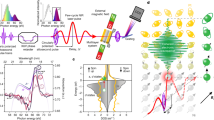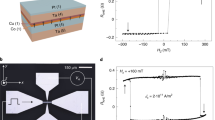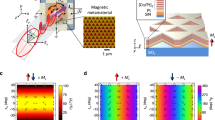Abstract
Controlling the intensity of emitted light and charge current is the basis of transferring and processing information1. By contrast, robust information storage and magnetic random-access memories are implemented using the spin of the carrier and the associated magnetization in ferromagnets2. The missing link between the respective disciplines of photonics, electronics and spintronics is to modulate the circular polarization of the emitted light, rather than its intensity, by electrically controlled magnetization. Here we demonstrate that this missing link is established at room temperature and zero applied magnetic field in light-emitting diodes2,3,4,5,6,7, through the transfer of angular momentum between photons, electrons and ferromagnets. With spin–orbit torque8,9,10,11, a charge current generates also a spin current to electrically switch the magnetization. This switching determines the spin orientation of injected carriers into semiconductors, in which the transfer of angular momentum from the electron spin to photon controls the circular polarization of the emitted light2. The spin–photon conversion with the nonvolatile control of magnetization opens paths to seamlessly integrate information transfer, processing and storage. Our results provide substantial advances towards electrically controlled ultrafast modulation of circular polarization and spin injection with magnetization dynamics for the next-generation information and communication technology12, including space–light data transfer. The same operating principle in scaled-down structures or using two-dimensional materials will enable transformative opportunities for quantum information processing with spin-controlled single-photon sources, as well as for implementing spin-dependent time-resolved spectroscopies.
This is a preview of subscription content, access via your institution
Access options
Access Nature and 54 other Nature Portfolio journals
Get Nature+, our best-value online-access subscription
$29.99 / 30 days
cancel any time
Subscribe to this journal
Receive 51 print issues and online access
$199.00 per year
only $3.90 per issue
Buy this article
- Purchase on Springer Link
- Instant access to full article PDF
Prices may be subject to local taxes which are calculated during checkout



Similar content being viewed by others
Data availability
All data generated and analysed in this work are available in a Zenodo repository (https://zenodo.org/records/10666881).
Change history
12 April 2024
A Correction to this paper has been published: https://doi.org/10.1038/s41586-024-07401-4
References
Waser, R. (ed.) Nanoelectronics and Information Technology: Advanced Electronic Materials and Novel Devices 3rd edn (Wiley-VCH, 2012).
Žutić, I., Fabian, J. & Das Sarma, S. Spintronics: fundamentals and applications. Rev. Mod. Phys. 76, 323–410 (2004).
Fiederling, R. et al. Injection and detection of a spin-polarized current in a light-emitting diode. Nature 402, 787–790 (1999).
Giba, A. E. et al. Spin injection and relaxation in p-doped (In,Ga)As/GaAs quantum-dot spin light-emitting diodes at zero magnetic field. Phys. Rev. Appl. 14, 034017 (2020).
Liang, S. H. et al. Large and robust electrical spin injection into GaAs at zero magnetic field using an ultrathin CoFeB/MgO injector. Phys. Rev. B 90, 085310 (2014).
Gerhardt, N. C. et al. Electron spin injection into GaAs from ferromagnetic contacts in remanence. Appl. Phys. Lett. 87, 032502 (2005).
Kim, Y.-H. et al. Chiral-induced spin selectivity enables a room-temperature spin light-emitting diode. Science 371, 1129–1133 (2021).
Chernyshov, A. et al. Evidence for reversible control of magnetization in a ferromagnetic material by means of spin–orbit magnetic field. Nat. Phys. 5, 656–659 (2009).
Miron, I. M. et al. Perpendicular switching of a single ferromagnetic layer induced by in-plane current injection. Nature 476, 189–193 (2011).
Liu, L. et al. Spin-torque switching with the giant spin Hall effect of tantalum. Science 336, 555–558 (2012).
Mishra, R., Kim, T., Park, J. & Yang, H. Shared-write-channel-based device for high-density spin-orbit-torque magnetic random-access memory. Phys. Rev. Appl. 15, 024063 (2021).
Lindemann, M. et al. Ultrafast spin-lasers. Nature 568, 212–215 (2019).
Miller, D. A. B. Attojoule optoelectronics for low-energy information processing and communications. J. Lightwave Technol. 35, 346–396 (2017).
Sandvine. The Global Internet Phenomena Report: COVID-19 Spotlight https://go.nature.com/49HrzWl (2020).
Jones, N. How to stop data centres from gobbling up the world’s electricity. Nature 561, 163–166 (2018).
Dery, H. et al. Spintronic nanoelectronics based on magneto-logic gates. IEEE Trans. Electron. Dev. 59, 259–262 (2012).
Vagionas, C. et al. Optical memory architectures for fast routing address look-up (AL) table operation. J. Phys. Photon. 1, 044005 (2019).
Sherson, J. F. et al. Quantum teleportation between light and matter. Nature 443, 557–560 (2006).
Zhan, X. et al. 3D laser displays based on circularly polarized lasing from cholesteric liquid crystal arrays. Adv. Mater. 33, 202104418 (2021).
Nishizawa, N. & Munekata, H. Lateral-type spin-photonics devices: development and applications. Micromachines 12, 644–675 (2021).
Ren, J.-G. et al. Ground-to-satellite quantum teleportation. Nature 549, 70–73 (2017).
Žutić, I. et al. Spin-lasers: spintronics beyond magnetoresistance. Solid State Commun. 316–317, 113949 (2020).
Zhang, Y. J., Oka, T., Suzuki, R., Ye, J. T. & Iwasa, I. Electrically switchable chiral light-emitting transistor. Science 344, 725–728 (2014).
Marin, J. F. G. et al. Room-temperature electrical control of polarization and emission angle in a cavity-integrated 2D pulsed LED. Nat. Commun. 13, 4884 (2022).
Nishizawa, N., Nishibayashi, K. & Munekata, H. A spin light emitting diode incorporating ability of electrical helicity switching. Appl. Phys. Lett. 104, 111102 (2014).
Yokota, N., Nisaka, K., Yasaka, H. & Ikeda, K. Spin polarization modulation for high-speed vertical-cavity surface-emitting lasers. Appl. Phys. Lett. 113, 171102 (2018).
Sinova, J. & Žutić, I. New moves of the spintronics tango. Nat. Mater. 11, 368–371 (2012).
Holub, M., Shin, J., Saha, D. & Bhattacharya, P. Electrical spin injection and threshold reduction in a semiconductor laser. Phys. Rev. Lett. 98, 146603 (2007).
Tsymbal, E. Y. & Žutić, I. Spintronics Handbook: Spin Transport and Magnetism 2nd edn (CRC Press, Boca Raton, FL, 2019).
Jhuria, K. et al. Spin–orbit torque switching of a ferromagnet with picosecond electrical pulses. Nat. Electron. 3, 680–686 (2020).
Li, H. et al. Field-free deterministic magnetization switching with ultralow current density in epitaxial Au/Fe4N bilayer films. ACS Appl. Mater. Interfaces 11, 16965–16971 (2019).
van den Brink, A. Field-free magnetization reversal by spin-Hall effect and exchange bias. Nat. Commun. 7, 10854 (2016).
Liu, L. et al. Symmetry-dependent field-free switching of perpendicular magnetization. Nat. Nanotechnol. 16, 277–282 (2021).
Pelucchi, E. et al. The potential and global outlook of integrated photonics for quantum technologies. Nat. Rev. Phys. 4, 194–208 (2022).
Fang, C. et al. Observation of the fluctuation spin Hall effect in a low-resistivity antiferromagnet. Nano Lett. 23, 11485–11492 (2023).
Lee, S. et al. Efficient conversion of orbital Hall current to spin current for spin-orbit torque switching. Commun. Phys. 4, 234 (2021).
Xie, H. et al. Orbital torque of Cr-induced magnetization switching in perpendicularly magnetized Pt/Co/Pt/Cr heterostructures. Chin. Phys. 32, 037502 (2023).
Kumar, S. & Kumar, S. Ultrafast THz probing of nonlocal orbital current in transverse multilayer metallic heterostructures. Nat. Commun. 14, 8185 (2023).
Zhang, C. et al. Magnetotransport measurements of current induced effective fields in Ta/CoFeB/MgO. Appl. Phys. Lett. 103, 262407 (2013).
Yu, G. et al. Switching of perpendicular magnetization by spin–orbit torques in the absence of external magnetic fields. Nat. Nanotechnol. 9, 548–554 (2014).
Rahaman, S. Z. et al. Pulse-width and temperature effect on the switching behavior of an etch-stop-on-MgO-barrier spin-orbit torque MRAM cell. IEEE Electron Device Lett. 39, 1306–1309 (2018).
Zhang, X., Vernier, N., Zhao, W., Vila, L. & Ravelosona, D. Extrinsic pinning of magnetic domain walls in CoFeB-MgO nanowires with perpendicular anisotropy. AIP Adv. 8, 056307 (2018).
Barate, P. et al. Bias dependence of the electrical spin injection into GaAs from Co–Fe–B/MgO injectors with different MgO growth processes. Phys. Rev. Appl. 8, 054027 (2017).
Iba, S., Koh, S., Ikeda, K. & Kawaguchi, H. Room temperature circularly polarized lasing in an optically spin injected vertical-cavity surface-emitting laser with (110) GaAs quantum wells. Appl. Phys. Lett. 98, 081113 (2011).
Frougier, J. et al. Control of light polarization using optically spin-injected vertical external cavity surface emitting lasers. Appl. Phys. Lett. 103, 252402 (2013).
Diamanti, E., Lo, H.-K., Qi, B. & Yuan, Z. Practical challenges in quantum key distribution. npj Quantum Inf. 2, 16025 (2016).
Žutić, I., Matos-Abiague, A., Scharf, B., Dery, H. & Belashchenko, K. Proximitized materials. Mater. Today 22, 85–107 (2019).
Sierra, J. F., Fabian, J., Kawakami, R. K., Roche, S. & Valenzuela, S. O. Van der Waals heterostructures for spintronics and opto-spintronics. Nat. Nanotechnol. 16, 856–868 (2021).
Belhadj, T. et al. Controlling the polarization eigenstate of a quantum dot exciton with light. Phys. Rev. Lett. 103, 086601 (2009).
Braun, P. F. et al. Direct observation of the electron spin relaxation induced by nuclei in quantum dots. Phys. Rev. Lett. 94, 116601 (2005).
Tao, B. et al. Atomic-scale understanding of high thermal stability of the Mo/CoFeB/MgO spin injector for spin-injection in remanence. Nanoscale 10, 10213–10220 (2018).
Cadiz, F. et al. Electrical initialization of electron and nuclear spins in a single quantum dot at zero magnetic field. Nano Lett. 18, 2381–2386 (2018).
Lu, Y. et al. Depth analysis of boron diffusion in MgO/CoFeB bilayer by X-ray photoelectron spectroscopy. J. Appl. Phys. 108, 043703 (2010).
Liu, B. et al. Spin injection probed by combined optical and electrical techniques in spin-LED. Phys. Status. Solidi. (c) 1, 475–478 (2004).
Lee, K.-M., Choi, J. W., Sok, J. & Min, B.-C. Temperature dependence of the interfacial magnetic anisotropy in W/CoFeB/MgO. AIP Adv. 7, 065107 (2017).
Huang, S. X., Chen, T. Y. & Chien, C. L. Spin polarization of amorphous CoFeB determined by point-contact Andreev reflection. Appl. Phys. Lett. 92, 242509 (2008).
Barate, P. et al. Electrical spin injection into InGaAs/GaAs quantum wells: A comparison between MgO tunnel barriers grown by sputtering and molecular beam epitaxy methods. Appl. Phys. Lett. 105, 012404 (2014).
Butler, W. H., Zhang, X.-G., Schulthess, T. C. & MacLaren, J. M. Spin-dependent tunneling conductance of Fe|MgO|Fe sandwiches. Phys. Rev. B 63, 054416 (2001).
Yuasa, S., Nagahama, T., Fukushima, A., Suzuki, Y. & Ando, K. Giant room-temperature magnetoresistance in single-crystal Fe/MgO/Fe magnetic tunnel junctions. Nat. Mater. 3, 868–871 (2004).
Parkin, S. S. P. et al. Giant tunnelling magnetoresistance at room temperature with MgO (100) tunnel barriers. Nat. Mater. 3, 862–867 (2004).
Lu, Y. et al. Spin-orbit coupling effect by minority interface resonance states in single-crystal magnetic tunnel junctions. Phys. Rev. B 86, 184420 (2012).
Jiang, X. et al. Highly spin-polarized room-temperature tunnel injector for semiconductor spintronics using MgO(100). Phys. Rev. Lett. 94, 056601 (2005).
Acknowledgements
We acknowledge B. Tao, S. Liang, A. Djeffal, T. H. Pham, J.-Y. Chen and M. Hehn for their contribution to the previous development of spin injectors. We thank S. Suire and C. Robert for their assistance with electroluminescence setups and L. Pasquier, O. Lerbert and D. Pierre for their help with MBE maintenance. We also acknowledge D. Crete for the discussion of the shunting problem. We appreciate the discussions on SOT spin-LEDs with A. Fert and Z.-G. Wang. We thank M. Hofmann for his support with the time-resolved photoluminescence measurements. This work is supported by the French National Research Agency (ANR) SOTspinLED project (no. ANR-22-CE24-0006-01), by the German Research Foundation (DFG) within the Reinhart-Koselleck-Project (no. 490699635), by the US National Science Foundation (NSF) Electrical, Communications and Cyber Systems grant no. 2130845 (I.Ž. for LEDs) and by the US Department of Energy (DOE) Office of Science Basic Energy Sciences (BES) award no. DE-SC0004890 (I.Ž. for SOT). This work is also partially financially supported by the National Natural Science Foundation of China (NSFC, grant no. 12134017). J.-P.W. thanks the partial support from the Robert Hartmann Endowed Chair Professorship and the National Science Foundation SHF: Small: Collaborative Research: Energy efficient strain-assisted spin transfer torque memory. We thank the French RENATECH network for the support of semiconductor growth and partial support from ‘Lorraine Université d’Excellence’ project (no. ANR-15-IDEX-04-LUE). The experiments were performed using equipment from the CC-DAUM, CC-MINALOR, CC-3M and CC-MAGCRYO platforms funded by FEDER (EU), ANR, the Region Lorraine and the metropole of Grand Nancy.
Author information
Authors and Affiliations
Contributions
Y.L. coordinated the research project. Y.L., P.A.D., J.-M.G., H.J., A.L. and M.M. conceived the sample structure. P.A.D., A.B., P.P., M.V. and J.-P.W. contributed to the fabrication of the spin injector. M.M., B.X. and A.L. grew the LED structure. P.A.D., P.R., L.L., D.L., M.S., G.C. and H.R. contributed to the electroluminescence characterizations. M.L. and N.C.G. carried out the TRPL characterizations. P.A.D., N.F.P., T.C., T.M., J.-M.G., H.J. and J.-C.R.S. characterized the magnetization switching of the spin injector. N.F.P. and P.A.D. performed the Kerr microscopy measurements. X.D. and P.A.D. performed the TEM characterizations. Y.L., I.Ž. and N.C.G. prepared the paper, with the help of P.A.D., X.D., P.R., X.M., M.C.B., H.J., J.-P.W., S.M. and X.H. All authors analysed the data, discussed the results and commented on the paper.
Corresponding author
Ethics declarations
Competing interests
The authors declare no competing interests.
Peer review
Peer review information
Nature thanks the anonymous reviewers for their contribution to the peer review of this work.
Additional information
Publisher’s note Springer Nature remains neutral with regard to jurisdictional claims in published maps and institutional affiliations.
Extended data figures and tables
Extended Data Fig. 1 Interfacial structure and chemical characterization of the spin injector.
a, Large-scale HR-STEM HAADF image showing a good homogeneity of the QD spin-LED multilayer structure. b, Enlarged HR-STEM BF image showing the injector multilayer structure. c, Maps for individual elements drawn from processed EELS spectrum images. d, Elemental profiles extracted from the maps of elements. The colors of the profile lines are consistent with the colors of the elemental maps in c.
Extended Data Fig. 2 RAHE of spin injector with a reversal of the in-plane Hx (compared to Fig. 2b in the main text).
RAHE of spin injector as a function of pulsed current, Ipulse, with the duration of tpulse = 0.1 s, at different temperatures with a small in-plane field Hx = +10 mT.
Extended Data Fig. 3 Polarization-resolved electroluminescence characterization of spin-LEDs.
a, Pc of the SOT spin-LED under bias, Vbias = +3.5 V (dashed lines with symbols) as a function of the out-of-plane magnetic field, Hz, and the corresponding SQUID hysteresis loop (blue solid line) measured at 300 K, respectively. The insets show the EL spectra measured at zero field, where Hz = ±0 T indicate that the sample M is first saturated by Hz = ±15 mT, respectively. b, Pc(T) of a standard spin-LED at a fixed Vbias = 3.5 V and Hz = 0 T. c, T dependence of τ and τs measured from the TRPL characterization, while the T dependence of the F factor is deduced from 1/(1+τ/τs). The error bars shown in (c) result from the fits of the time transients (see Extended Data Fig. 9).
Extended Data Fig. 4 Bias dependence of circular polarization measured in the SOT spin-LED.
a–e, EL spectra of the SOT spin-LED measured at 300 K and Hz = 0 T, with Vbias: (a) 1.7 V, (b) 2.26 V, (c) 2.4 V, (d) 2.88 V, (e) 3.1 V. f, Pc as a function of Vbias at 300 K and Hz = 0 T, for the SOT spin-LED.
Extended Data Fig. 5 Temperature dependence of circular polarization measured in the standard spin-LED.
a–f, EL spectra of the standard spin-LED measured at Hz = 0 T, with Vbias = 3.5 V and different T. (a) 10 K, (b) 100 K, (c) 150 K, (d) 200 K, (e) 250 K, (f) 300 K.
Extended Data Fig. 6 Repetition measurement of Pc at 300 K after different number of switching.
EL spectra of the SOT spin-LED measured at Hz = 0 T and Vbias = 3.5 V with a repetition of a single pulsed current M switching. a, First switching, b, 10th switching, c, 19th switching, d, 28th switching, e, 37th switching, and f, 46nd switching.
Extended Data Fig. 7 Stability of the ferromagnet/semiconductor Schottky interface after magnetization switching.
I−Vbias curves of the SOT spin-LED measured before and after the repetition switching at 300 K.
Extended Data Fig. 8 Pc loop as a function of pulsed switching current.
a, Pc loop as a function of the switching pulsed current, Ipulse, measured at 300 K. Each M switching is at Hx = +10 mT. b-h, EL spectra of the SOT spin-LED measured at Hz = 0 T and Vbias = 3.5 V after M switching corresponding to each point numbered in (a). For one loop, it starts from (b) +25 mA to (c) −15 mA, (d) −18 mA, (e) −25 mA, (f) −15 mA, (g) +18 mA, and (h) +20 mA.
Extended Data Fig. 9 Time-resolved photoluminescence and the extraction of spin and carrier lifetimes.
a, Typical PL intensity mapping at 100 K for QD LEDs as a function of time and photon wavelength. b, QD TRPL intensity evolution for the Sσ+ and Sσ− components measured at 300 K. c, Determination of τ from the exponential fit of the decay time for the PL intensity (Sσ+ + Sσ−). d, Determination of τs from the exponential fit of the decay time of Pc. The error bars shown in (c,d) result from the fits of the time transients.
Supplementary information
Supplementary Information
Supplementary Notes 1–8, including Supplementary Figs 1–8 and Supplementary Tables 1 and 2, and Supplementary References.
Rights and permissions
Springer Nature or its licensor (e.g. a society or other partner) holds exclusive rights to this article under a publishing agreement with the author(s) or other rightsholder(s); author self-archiving of the accepted manuscript version of this article is solely governed by the terms of such publishing agreement and applicable law.
About this article
Cite this article
Dainone, P.A., Prestes, N.F., Renucci, P. et al. Controlling the helicity of light by electrical magnetization switching. Nature 627, 783–788 (2024). https://doi.org/10.1038/s41586-024-07125-5
Received:
Accepted:
Published:
Issue Date:
DOI: https://doi.org/10.1038/s41586-024-07125-5
Comments
By submitting a comment you agree to abide by our Terms and Community Guidelines. If you find something abusive or that does not comply with our terms or guidelines please flag it as inappropriate.



